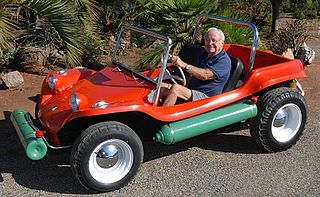
A dune buggy — also known as a beach buggy — is a recreational off-road vehicle with large wheels, and wide tires, designed for use on sand dunes, beaches, off-road or desert recreation. The design is usually a topless vehicle with a rear-mounted engine. A dune buggy can be created by modifying an existing vehicle or custom-building a new vehicle.

Naples is a city in Collier County, Florida, United States. As of the 2020 census, the population was 19,115. Naples is a principal city of the Naples-Marco Island, Florida Metropolitan Statistical Area, which had a population of about 375,752 as of 2020. Naples' USPS City population includes most of the communities in Collier County with the notable exceptions of Immokalee, Marco Island, Ave Maria, Everglades City and a few others, and thus Naples' USPS City population is approximately 333,083.

An amphibious vehicle, is a vehicle that is a means of transport viable on land as well as on or under water. Amphibious vehicles include amphibious bicycles, ATVs, cars, buses, trucks, railway vehicles, combat vehicles and hovercraft.

Everglades National Park is an American national park that protects the southern twenty percent of the original Everglades in Florida. The park is the largest tropical wilderness in the United States and the largest wilderness of any kind east of the Mississippi River. An average of one million people visit the park each year. Everglades is the third-largest national park in the contiguous United States after Death Valley and Yellowstone. UNESCO declared the Everglades & Dry Tortugas Biosphere Reserve in 1976 and listed the park as a World Heritage Site in 1979, and the Ramsar Convention included the park on its list of Wetlands of International Importance in 1987. Everglades is one of only three locations in the world to appear on all three lists.

An all-terrain vehicle (ATV), also known as a light utility vehicle (LUV), a quad bike or quad, as defined by the American National Standards Institute (ANSI), is a vehicle that travels on low-pressure tires, has a seat that is straddled by the operator, and has handlebars. As the name implies, it is designed to handle a wider variety of terrain than most other vehicles. It is street-legal in some countries, but not in most states, territories and provinces of Australia, the United States, and Canada.
Off-road transport is moving people or articles on land without the use of paved roads, typically using off-road vehicles.

An off-road vehicle (ORV), sometimes referred to as an off-highway vehicle (OHV), overland vehicle, or adventure vehicle, is considered to be any type of vehicle which is capable of driving off paved or gravel surfaces, such as trails and forest roads that have rough and low traction surfaces.
The Tamiami Trail is the southernmost 284 miles (457 km) of U.S. Highway 41 (US 41) from State Road 60 (SR 60) in Tampa to US 1 in Miami. A portion of the road also has the hidden designation of State Road 90 (SR 90).

Off-roading is the activity of driving or riding in a vehicle on unpaved surfaces such as sand, dirt, gravel, riverbeds, mud, snow, rocks, and other natural terrain. Types of off-roading range in intensity, from leisure drives with unmodified vehicles to competitions with customized vehicles and professional drivers.

The Meyers Manx dune buggy is a small recreationally-oriented automobile, designed initially for desert racing by Californian engineer, artist, boat builder and surfer Bruce F. Meyers. It was produced by his Fountain Valley, California company, B. F. Meyers & Co. from 1964 to 1971, in the form of car kits applied to shortened chassis of Volkswagen Beetles. The car line dominated dune racing in its time, breaking records immediately, and was eventually also released in street-oriented models, until the company's demise due to tax problems after Meyers's departure. New vehicles inspired by the original Manx buggy have been produced by Meyers's re-founded operation, Meyers Manx, Inc., since 2000. The name and cat logo of the brand derives from the Manx cat, by virtue of the tailless breed's and the shortened vehicle's truncated "stubbiness".
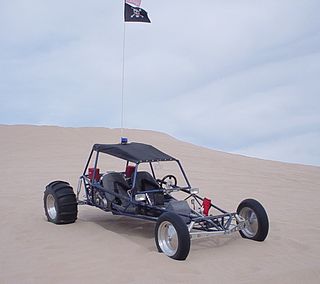
A sandrail, also called a sand rail, rail, or sand car, is a lightweight off-road motor vehicle specifically built for traveling in sandy terrain. Similar in some respects and often mistakenly referred to as a dune buggy or sand car, a sandrail is a different type of speciality vehicle. Sandrails are popularly operated on actual sand dunes. Sandrails can be driven on other types of terrain but are designed specifically for sand.

Paddle tires are mainly used on off-road vehicles, specifically designed for use in sand and mud. They consist of a smooth tire core which has a series of large rubber cups attached to it. The volume inside of a paddle is much larger than the void of a knobby tire, so it is unlikely to clog up with sand/mud. A street legal mud tire is a more or less normal tire, but with extra large gaps or "voids" between each tread block to allow centrifugal force to "self-clean" or fling the mud out of the gap. Smaller gaps trap the mud in between the tire lugs, which turns the tire into something resembling a "slick" with no tread at all, which will have no traction in mud.
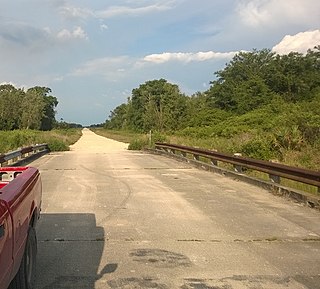
Picayune Strand State Forest is one of 37 state forests in Florida managed by the Florida Forest Service. The 78,000-acre forest consists primarily of cypress swamps, wet pine flatwoods and wet prairies. It also features a grid of closed roads over part of it, left over from its previous land development schemes.

Snow chains, or tire chains, are devices fitted to the tires of vehicles to provide increased traction when driving through snow and ice.
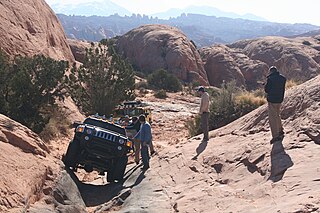
Rock crawling is an extreme form of off-road driving using specialized vehicles ranging from stock to highly modified to overcome obstacles. In rock crawling, drivers typically drive highly modified four-wheel-drive vehicles such as trucks, Jeeps, and "buggies" over very harsh terrain. Driving locations include boulders, mountain foothills, rock piles, mountain trails, etc.
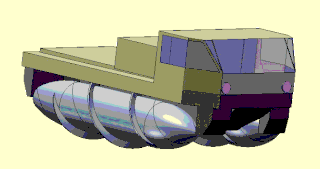
A screw-propelled vehicle is a land or amphibious vehicle designed to cope with difficult terrain, such as snow, ice, mud, and swamp. Such vehicles are distinguished by being moved by the rotation of one or more auger-like cylinders fitted with a helical flange that engages with the medium through or over which the vehicle is moving. They have been called Archimedes screw vehicles by the US military, where they are classified as a type of marginal terrain vehicle (MTV). Modern vehicles called Amphirols and other similar vehicles have specialised uses.
Mud bogging is a form of off-road motorsport popular in Canada and the United States in which the goal is to drive a vehicle through a pit of mud or a track of a set length. Winners are determined by the distance traveled through the pit. However, if several vehicles are able to travel the entire length, the time taken to traverse the pit will determine the winner. Typically, vehicles competing in mud bogs are four-wheel drive. The motor sport is overseen by sanctioning bodies like the American Mud Racers Association, and the National Mud Racing Organization (NMRO), that oversee each class, develop and maintain the relationship with track owners to provide a racer and fan-friendly facility, ensure the sponsors get a good return, and help govern the sport.

An amphibious all-terrain vehicle, amphibious ATV, is a small, all-wheel drive, all-terrain amphibious vehicle, used for recreation, farm-, hunting, utility or industry tasks, by enthusiasts and professionals worldwide. They are legally off-highway vehicles in many countries, or at least restricted from use on express highways and motorways – their use is generally extra-urban.

The Amphicat is a six-wheel-drive, skid steer amphibious all-terrain vehicle invented in Spain by José Artés de Arcos, manufactured in the late 1960s through the early 1970s by Mobility Unlimited Inc. of Auburn Hills, Michigan. The product line was purchased by “Magna American” which produced the vehicle in Raymond, Mississippi for several years. The vehicle was also made in Canada by Behoo Industries and differed slightly from its American counterpart, mostly on the transom.

An amphibious automobile is an automobile that is a means of transport viable on land as well as on or under water. They are unarmored for civilian use.
















